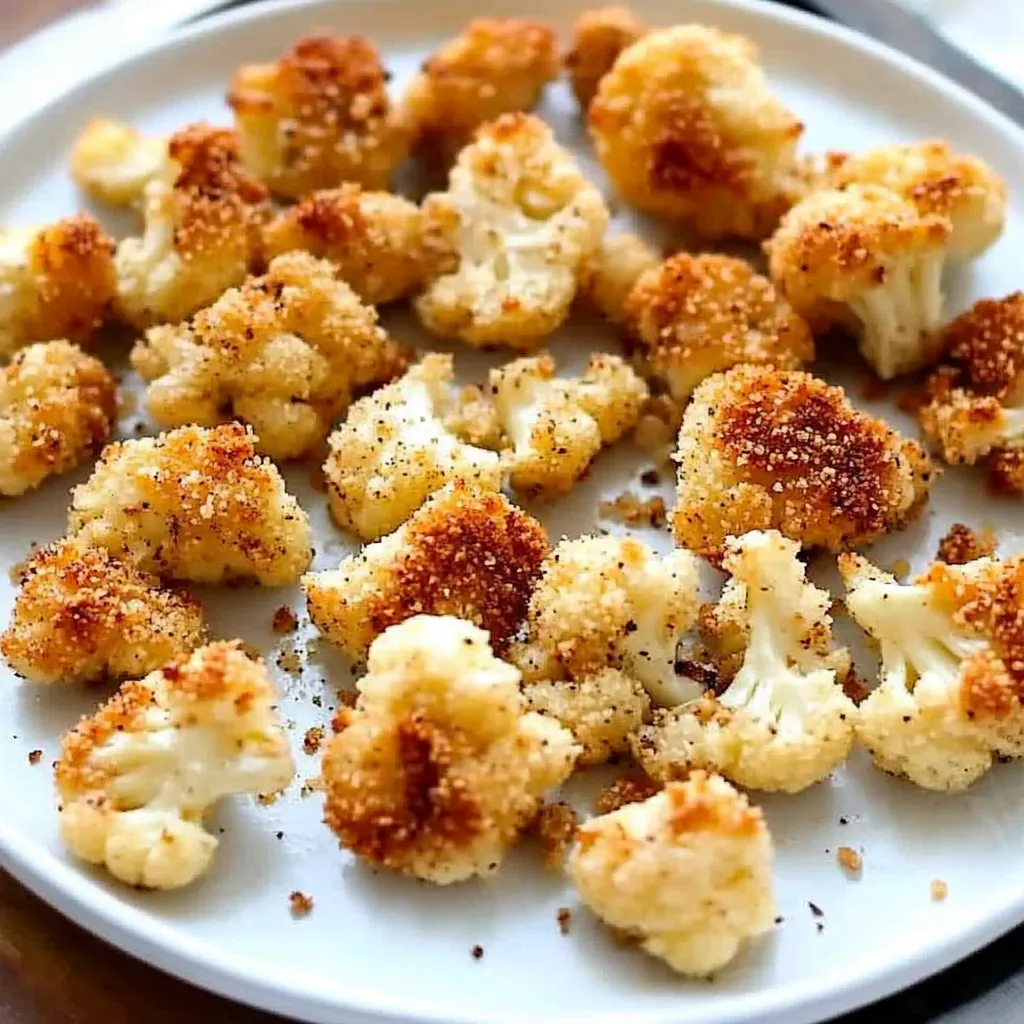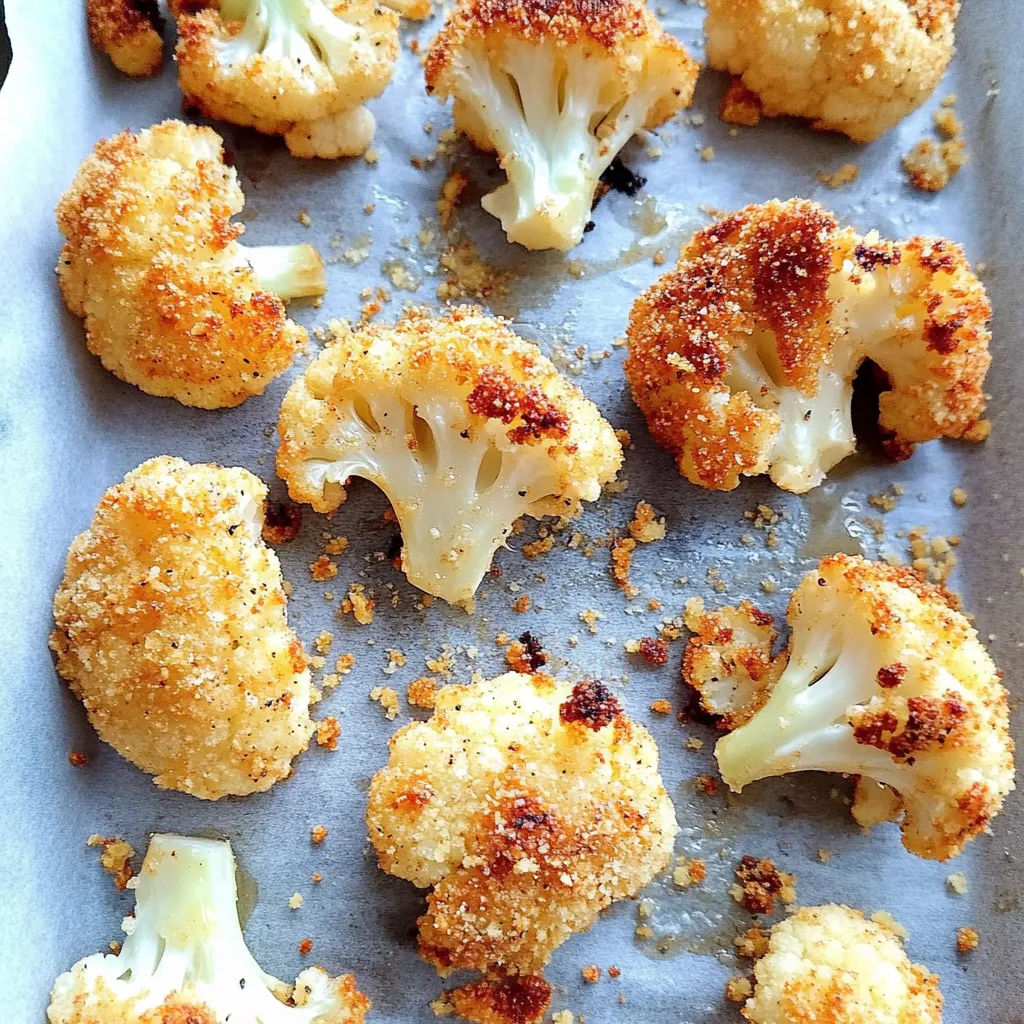 Pin it
Pin it
This irresistible roasted garlic Parmesan cauliflower transforms the humble vegetable into crispy, golden bites that deliver restaurant-quality flavor with minimal effort. Each perfectly roasted floret develops a delightful contrast between its tender interior and crispy exterior, all enhanced by a savory coating of buttery garlic, fresh Parmesan, and toasted breadcrumbs. Unlike typical fried versions that can be heavy and oil-laden, this oven-roasted method creates the same satisfying crunch while allowing the cauliflower's natural flavors to shine through. Perfect as a versatile side dish that complements almost any main course, an impressive appetizer with dipping sauce, or even a satisfying snack, these addictively crispy bites will convert even the most committed vegetable skeptics into cauliflower enthusiasts.
My journey with this recipe began when trying to convert my cauliflower-averse husband into appreciating this versatile vegetable. The first time I served these crispy, golden bites, he reached for seconds before finishing his first helping—a culinary miracle in our household. What was meant to be a simple side dish became the star of the meal, with everyone at the table discussing how something as simple as cauliflower could taste so extraordinary. Now it's my most-requested contribution to family gatherings, where the platter empties with surprising speed and guests incredulously ask, "This is just cauliflower?" That moment of revelation—when people discover how magnificent this humble vegetable can be—has become my favorite part of sharing this dish.
Essential Ingredients
- Fresh Cauliflower: Forms the foundation of this dish, providing a neutral canvas that absorbs the surrounding flavors while developing its own nutty sweetness through roasting. Fresh cauliflower delivers the perfect texture contrast between crisp exterior and tender interior that frozen varieties simply cannot achieve. Select heads that feel heavy for their size with tightly closed, cream-colored florets for optimal freshness and flavor.
- Butter: Creates the rich foundation that allows the breading to adhere while contributing to the golden-brown exterior. Its milk solids caramelize during roasting, adding complex flavor notes that vegetable oil cannot replicate. The butter also carries fat-soluble flavors throughout each bite, ensuring the garlic and Parmesan notes permeate the entire cauliflower piece rather than remaining only on the surface.
- Fresh Garlic: Provides aromatic depth that transforms from sharp pungency to caramelized sweetness during roasting. Fresh garlic cloves offer significantly more dimension than powder, developing complex flavor as they roast alongside the cauliflower. The subtle sweetness that emerges during cooking balances the savory Parmesan while complementing cauliflower's natural characteristics.
- Breadcrumbs: Deliver the essential crispy exterior that makes this dish so satisfying. Regular breadcrumbs create the ideal coating thickness—substantial enough to provide crunch without overwhelming the cauliflower itself. Their fine texture allows for even browning while maximizing surface contact, creating a uniformly golden crust that seals in moisture.
- Parmesan Cheese: Contributes savory depth, salt, and umami qualities that elevate the entire dish. As it roasts, Parmesan develops crispy, nutty characteristics that perfectly complement cauliflower's subtle flavor. Freshly grated Parmesan incorporates more seamlessly into the breading mixture while melting more consistently during roasting than pre-grated varieties.
- Italian Seasoning: Provides aromatic complexity through its blend of herbs that enhance both the cauliflower and the Parmesan. The combination of dried basil, oregano, thyme, and other Mediterranean herbs infuses the dish with subtle earthiness and complexity that would be difficult to achieve through individual seasonings.
Step-by-Step Cooking Instructions
- Prepare your cauliflower for optimal roasting -
- Preheat your oven to 400°F (200°C) and line a large baking sheet with parchment paper for easy cleanup. Remove the leaves from one medium cauliflower head and cut it into evenly-sized florets, approximately 1½ to 2 inches in size. Consistent sizing ensures uniform cooking, preventing some pieces from burning while others remain undercooked. Rinse the florets briefly under cold water and thoroughly pat dry with paper towels—this crucial drying step ensures crispiness rather than steaming during roasting.
- Create your flavorful coating mixture -
- In a large bowl, combine ¾ cup plain breadcrumbs, ½ cup freshly grated Parmesan cheese, 1 teaspoon Italian seasoning, ½ teaspoon garlic powder, ½ teaspoon salt, and ¼ teaspoon freshly ground black pepper. Mix thoroughly with a fork until all ingredients are evenly distributed. This uniform distribution ensures consistent flavor across all cauliflower pieces. Set aside while preparing the remaining components.
- Prepare your garlic butter binding agent -
- Melt 4 tablespoons of unsalted butter in a small saucepan over medium-low heat. Once melted, add 3 minced garlic cloves and cook for 30-60 seconds until fragrant but not browned. Browning the garlic at this stage would create bitter notes in the final dish. Remove from heat and allow to cool slightly while the garlic flavor infuses into the butter. This garlic-infused butter will help the coating adhere while distributing garlic flavor throughout each cauliflower piece.
- Coat your cauliflower using the dip method -
- Working with a few florets at a time, dip each cauliflower piece into the garlic butter, allowing excess to drip off, then immediately place in the breadcrumb mixture. Roll and press gently to ensure the coating adheres to all surfaces. Transfer the coated florets to the prepared baking sheet, arranging them in a single layer with small spaces between each piece. This separation allows hot air to circulate freely, creating crispy exteriors all around rather than just on top.
- Create perfectly crispy texture through proper arrangement -
- Continue the coating process until all cauliflower pieces are breaded and arranged on the baking sheet. If you have remaining butter mixture, drizzle it lightly over the coated florets. If you have remaining breadcrumb mixture, sprinkle it over the top of the arranged cauliflower. This additional layer enhances crispness and ensures no flavor is wasted. The single-layer arrangement with space between pieces is essential for proper browning rather than steaming.
- Roast to golden perfection -
- Place the baking sheet in the preheated oven and roast for 25-27 minutes, or until the coating is golden brown and crispy and the cauliflower is tender when pierced with a fork. For even browning, rotate the baking sheet halfway through cooking time. The cauliflower is perfectly cooked when a knife inserted into a larger piece meets slight resistance rather than sliding through too easily, which would indicate overcooking.
- Finish with fresh elements -
- Remove from the oven and immediately sprinkle with 2 tablespoons additional freshly grated Parmesan and 1 tablespoon chopped fresh parsley for color contrast and fresh flavor. Allow to cool for 3-5 minutes, which lets the exterior crisp further while allowing the interior to set, preventing the coating from falling off during serving. Transfer to a serving platter and enjoy immediately while the contrast between crispy exterior and tender interior is at its peak.
 Pin it
Pin it
The Cauliflower Renaissance
Once relegated to bland vegetable platters or smothered in cheese sauce to mask its flavor, cauliflower has undergone a remarkable culinary renaissance in recent years. This versatile vegetable has moved from afterthought to star ingredient as chefs and home cooks have discovered its remarkable adaptability.
What makes cauliflower particularly special is its chameleon-like ability to transform through different cooking methods. Raw, it offers crisp texture and subtle pepperiness. Steamed, it becomes tender but often uninspiring. But roasted—ah, that's where the magic happens. The high, dry heat of roasting triggers the Maillard reaction, caramelizing the natural sugars in cauliflower and developing complex nutty, sweet notes completely absent in other cooking methods.
I discovered this transformation accidentally when a failed attempt at steamed cauliflower was salvaged by tossing it into a hot oven to keep warm before dinner. That unintentional roasting opened my eyes to cauliflower's hidden potential. The browned edges and concentrated flavor bore little resemblance to the mild vegetable I thought I knew.
During a cooking class focused on vegetable preparation, the chef explained that cauliflower contains compounds called glucosinolates that, when cooked properly, break down into new flavor molecules that give roasted cauliflower its distinctive, almost meaty satisfaction. This scientific explanation confirmed what my taste buds had already discovered—roasting completely transforms this vegetable's flavor profile.
The Science of Perfect Breading
Creating the ideal crispy coating without deep-frying relies on understanding the interplay between fat, heat, and surface texture. This recipe employs several key principles that professional chefs use to create crunchy textures without excessive oil.
First, the cauliflower must be thoroughly dried before coating. Any excess moisture creates steam during cooking that prevents proper browning and causes the coating to become soggy rather than crisp. This is why restaurant kitchens often pat ingredients dry multiple times before breading.
Second, the butter serves multiple crucial functions beyond flavor. Its fat content helps the breadcrumbs adhere while also conducting heat more efficiently than the cauliflower itself would. As the butter heats, it essentially fries the coating from within, creating crispness despite being in a dry oven environment.
The Parmesan within the breading mixture contributes significantly to both flavor and texture. As it heats, Parmesan's proteins undergo structural changes that create additional crispness while its fat content melts slightly, further binding the coating together.
I learned the importance of proper spacing through trial and error. My first attempt arranged the cauliflower too closely, essentially steaming the pieces rather than roasting them. The cold baking sheet also lowered the initial cooking temperature. Now I always preheat the baking sheet along with the oven, creating immediate searing when the coated cauliflower is added—another restaurant technique that significantly improves browning.
I discovered through experimentation that adding a small amount of cornstarch (about 1 tablespoon) to the breadcrumb mixture creates an even crispier coating. This modification came about when cooking for a friend who mentioned restaurant kitchens often use this technique. The difference was subtle but noticeable—the exterior stayed crisp longer after coming out of the oven.
The most valuable insight I gained after numerous batches was the impact of baking sheet material on the final result. Dark, non-stick baking sheets produce more intense browning on the bottom of the florets, sometimes excessively so. My preferred method now uses a heavy-gauge aluminum sheet lined with parchment, which creates even coloration all around each piece.
This roasted garlic Parmesan cauliflower represents what I love most about thoughtful cooking—how understanding ingredients and techniques can transform something ordinary into something remarkable. It reminds us that vegetables deserve the same care and attention often reserved for proteins, and that simplicity, when executed with attention to detail, often yields the most satisfying results. Whether served alongside a special dinner or enjoyed as a snack while watching the game, these crispy cauliflower bites demonstrate that plant-based foods can be every bit as crave-worthy as their meat counterparts.
Frequently Asked Questions
- → Can I use frozen cauliflower for this recipe?
- Fresh cauliflower works best as frozen cauliflower tends to release too much moisture during baking, making the coating soggy.
- → How do I store leftovers?
- Store leftovers in an airtight container in the refrigerator for up to 3 days. Reheat in the oven at 350°F for 10 minutes to crisp them back up.
- → Can I make this recipe gluten-free?
- Yes, simply substitute the regular breadcrumbs with gluten-free breadcrumbs and ensure your Parmesan cheese is labeled gluten-free.
- → What dipping sauces go well with this?
- Ranch dressing, marinara sauce, garlic aioli, or even a simple sriracha mayo all pair wonderfully with these cauliflower bites.
- → Can I make this ahead of time?
- You can prepare the cauliflower florets and coating mixtures ahead of time, but for best results, bread and bake just before serving for maximum crispiness.
